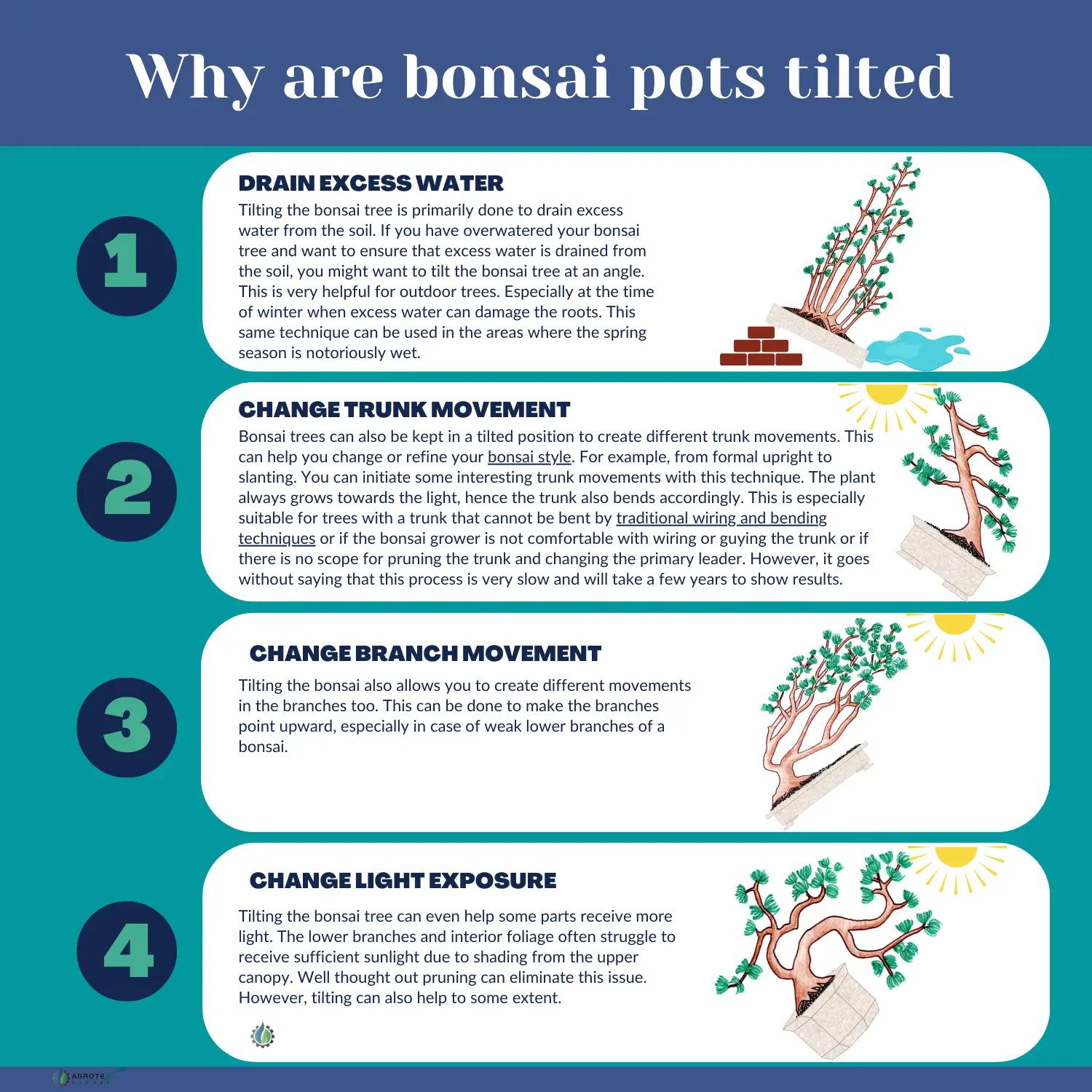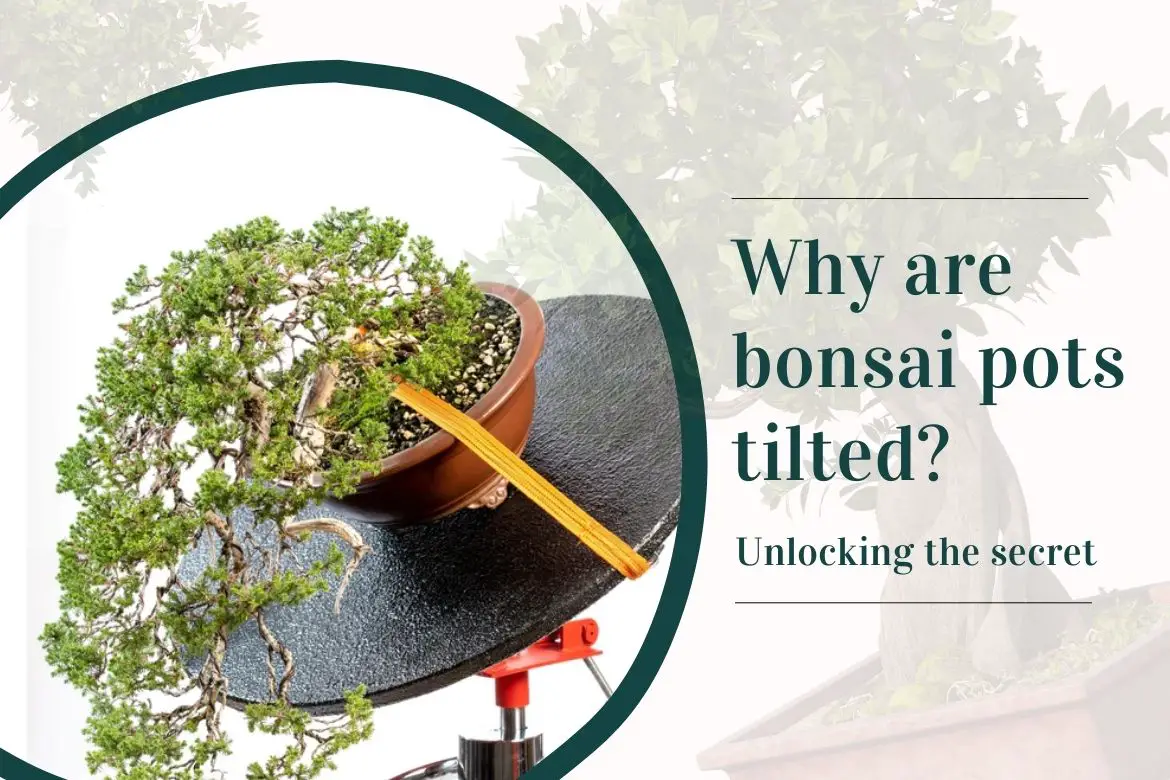Apart from regular bonsai maintenance and care practices such as watering, fertilizing, pruning, repotting and wiring, bonsai enthusiasts often employ various other techniques to care for their bonsai trees or to even enhance the shape of the bonsai. One such technique involves tilting the bonsai pot. But why do you tilt a bonsai pot?
In this article we are not going to talk about the tilting we perform while pruning the bonsai tree (it makes the job of pruning hard to reach areas much easier – Pruning the tree without being in an awkward position is pure bliss!). Or when we tilt the bonsai on a tilting turntable to observe the bonsai tree for flaws, scope of improvement or pest and diseases. (For bonsai beginners: Yes, there are tilting work benches available in the market for your bonsai. They make the job of maintenance work on a bonsai tree a little easier and more enjoyable. Read more about tilting turntables in Bonsai tools and uses).
Here we are going to shed some light on why some bonsai enthusiasts prefer tilting their bonsai trees for a prolonged period of time. Bonsai pots are generally tilted for draining excess water (primary reason), change the shape of the bonsai by introducing different trunk and branch movements, and change and enhance the light exposure. Let’s examine it in more detail:
- Tilting the bonsai tree is primarily done to drain excess water from the soil. If you have overwatered your bonsai tree and want to ensure that excess water is drained from the soil, you might want to tilt the bonsai tree at an angle. This is very helpful for outdoor trees. Especially at the time of winter when excess water can damage the roots. This same technique can be used in the areas where the spring season is notoriously wet. Some bonsai growers find it difficult to believe that tilting the bonsai tree helps in drainage of water until they try it themselves. Just as an experiment, water your bonsai thoroughly and wait for water to stop coming out of the bonsai pot. Now tilt the bonsai pot. You will see more water coming out of the drainage holes. Continue reading How to water your bonsai tree.
- Bonsai trees can also be kept in a tilted position to create different trunk movements. This can help you change or refine your bonsai style. For example, from formal upright to slanting. You can initiate some interesting trunk movements with this technique. The plant always grows towards the light, hence the trunk also bends accordingly. This is especially suitable for trees with a trunk that cannot be bent by traditional wiring and bending techniques or if the bonsai grower is not comfortable with wiring or guying the trunk or if there is no scope for pruning the trunk and changing the primary leader. However, it goes without saying that this process is very slow and will take a few years to show results.
- Tilting the bonsai also allows you to create different movements in the branches too. This can be done to make the branches point upward, especially in case of weak lower branches of a bonsai. Also, at this point, wire the desired branches if possible. However, wiring will depend on the type of bonsai tree you are growing. Hence be absolutely sure before doing it.
- Tilting the bonsai tree can even help some parts receive more light. The lower branches and interior foliage often struggle to receive sufficient sunlight due to shading from the upper canopy. Well thought out pruning can eliminate this issue. However, tilting can also help to some extent. Continue reading Do bonsai trees need sun. For indoor bonsai trees, instead of using this technique, you can use grow lights. Continue reading Grow indoor bonsai tree with led grow lights.

Must read : What is the rule for bonsai pots? and What is the best shape for bonsai pots?
Challenges while tilting the bonsai pot
Apart from some advantages there are also some challenges you might face when tilting your bonsai pot for a long time. Following are some:
(1) Stability and Balance: Tilting a bonsai pot alters its center of gravity, which can affect the stability and balance of the tree. It’s crucial to ensure that the tilted pot remains securely in place and doesn’t tip over easily. Extra precautions may be required, such as using additional support or anchoring techniques, to maintain stability and prevent the pot from shifting or falling. To ensure the stability, you can use a tilting turntable that has straps to secure the bonsai pot. See the following example:

(2) Root Alignment: Tilting the pot can influence the direction and growth pattern of the roots. As the tree adapts to the tilted position, the roots may begin to grow in a manner that aligns with the new angle. It’s important to periodically check the root system and make necessary adjustments to maintain a healthy root structure that supports the tree’s stability and growth.
(3) Time consuming: In case you are planning to use this tilting technique to change the shape of your bonsai tree, keep in mind that it will take years for the tree to achieve the desired shape.
Conclusion
While there may be challenges to address, such as stability and root alignment, with careful attention and proper techniques, tilting a bonsai pot can bring both aesthetic and practical benefits. Furthermore, this can also be a fun experiment that will give bonsai growers (especially novice bonsai growers) valuable experience in the art of bonsai.

